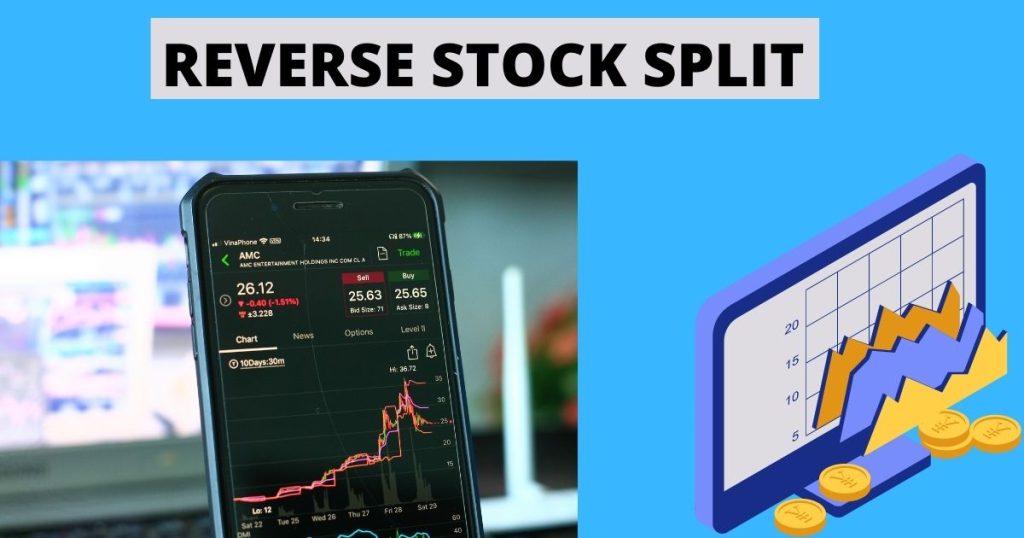This article is a detailed guide about reverse stock split. Here I have discussed about three different strategies on “How to profit from a reverse stock split?”. So, if your are hungry to learn about reverse stock split, you must read this article till end .

Topics Covered In This Article:
- What is a Reverse Stock Split?
- What is the process of a reverse stock split?
- What are the Benefits of Reverse Stock Splitting?
- How to Profit From a Reverse Stock Split?- 3 Strategies
- How to Calculate the Value of Your Shares Before & After the Reverse Split?
Now, let’s begin our discussion by understanding the concept of reverse stock split.
What is Reverse Stock Split?
A reverse stock split is when a company decreases the number of shares outstanding by issuing more shares or reducing the price per share. The company does this in order to make their stocks more attractive and accessible to investors.
So, it is a way for companies to decrease their share prices without having to go through the process of going public. Reverse stock splits can also be used as a means of raising capital for investing in other companies, or buying back shares from shareholders at an attractive price.
What is the process of a reverse stock split?
A reverse stock split is a corporate action in which a company reduces the number of its outstanding shares by merging them into fewer shares.
There are two types of reverse stock splits: a forward split and a reverse split. A forward split is where the number of outstanding shares is increased, while a reverse split is where the number of outstanding shares is decreased.
Reverse stock split is done in the following three steps:
Step 1: It starts with the board issuing an authorization for the company to issue new securities in order to reduce the number of its outstanding shares.
Step 2: There will be an announcement about what type of securities will be issued by this company and how many new shares will be issued for every old share.
Step 3: Finally, the company conducts the reverse split.
What are the Benefits of Reverse Stock Splitting?
When a company performs reverse stock splits, the number of shares that each shareholder receives increases, but the percentage ownership stake in the company decreases.
The goal of a reverse stock split is to make the company’s stocks more attractive to investors. The lower share prices should make it easier for retail investors to buy and sell them, and should also reduce the cost burden on individual investors who are buying and selling them as part of their retirement portfolios.
3 Benefits of Reverse Stock Splits are:
- A reverse stock split reduces share price volatility by increasing the number of outstanding shares, which has a stabilizing effect on share prices.
- A reverse stock split also helps with dilution by reducing the amount of new shares being issued for every transaction, and thus decreasing the amount of dilutive effects on earnings per share (EPS).
- A reverse stock split can also help with taxes by reducing taxable income, thereby lowering tax bills and improving cash flow for shareholders.
How to Profit From a Reverse Stock Split?- 3 Strategies
In stock market, investors make profit when they buy stocks at lower price and sell it at higher price. The reverse stock split increases the share price, which means that investors make more money on their investment.
3 Strategies to Profit From Reverse Stock Split are as Below:
Strategy 1: Buying shares before the reverse stock split is announced
If you have not yet bought shares and are aware of a company, it could be a good idea to buy shares before the company announces it is going to do a reverse stock split. You can have chance to sell share at higher price when company announces reverse stock split.
Strategy 2: Sell your shares before the reverse stock splits takes place
If you know that your company is about to perform a reverse stock split, then you should sell your shares before it happens. This way, you can take advantage of the increase in share price while also reducing your risk.
Strategy 3: Buying shares after the reverse-stock split takes place
After reverse stock is done, you will have the chance to buy at lower price. And, if you succeed in buying share instantly at lower price, you can sell it at higher price when it increases. But, you should be intelligent enough to analyze the company and stock market.
How to Calculate the Value of Your Shares Before & After the Reverse Split?
The reverse stock split will not affect your holdings in the company, but it will affect the value of your investment. So how do you calculate the value of your shares before and after the reverse split?
In order to calculate the value of your holdings before and after the reverse split, you need to know how many shares you own and how many new shares you will own after splitting. If we assume that we have 10,000 original shares at $2 each, then following a 1-for-10 reverse stock split, we would have 10,000 new shares at $0.
So, this much is for our today’s explanation on the topic “How to Profit From a Reverse Stock Split?”. If you have any confusion regarding reverse stock split, please ask a question in the comment box as below. Thank You !
Read Our Other Articles:
How Do Brokers Profit From Short Selling In Stock Market?